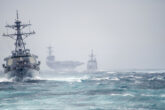May 10, 2024
Space to Grow
Foundational Opportunities and Challenges for the U.S. Space Force
Executive Summary
In the more than 50 years since the first satellite launch, space has become irrevocably intertwined with the American way of life and the American way of war. During the Cold War, it provided early warning of missile attacks and supported nuclear command, control, and communications, thereby stabilizing competition in a fraught nuclear era. After the Cold War, space became a critical part of the U.S. conventional way of war, providing surveillance capabilities, supplying high-bandwidth communications, and supporting precision strike through the deployment of GPS. In recent years, potential adversaries have recognized space as a key American military strength and focused on developing the ability to neutralize it. Both China and Russia, priority threats in the 2022 National Defense Strategy, have demonstrated capabilities that would allow them to deny U.S. use of space and have voiced a willingness to use these counterspace capabilities if necessary. Thus, space, long acknowledged as a vital war-supporting domain, is increasingly seen as a domain of war in itself. In December 2019, the U.S. Space Force was created in acknowledgment of the importance and vulnerability of U.S. space-based capabilities.
The Space Force’s mandate is to organize, train, and equip forces to “provide freedom of operation for the United States in, from, and to space; conduct space operations; and protect the interests of the United States in space.”1 At its birth, the Space Force inherited a passionate cadre of military space professionals and world-class space assets; it also inherited a bureaucracy, mature 21st-century adversaries, and the pressure to quickly become a world-class military force. As a new service, the Space Force has had to define, differentiate, and justify itself while working jointly with fellow services and integrating with civil space, commercial space, and allies and partners. It has had to do so in an environment where some have perceived it to be at best superfluous and at worst harmful.
If the Space Force is to prevail in the already fierce interservice competition for resources, relevance, and missions and achieve its founding objectives, it needs three things: First, it needs a well-articulated and communicated strategic concept—that is, an explanation of its purpose and unique contribution to national security. Second, it needs an organizational plan that follows logically from and institutionalizes that strategic concept. Third, it needs a vision for a distinct and cohesive service culture, initially dictated from the top down through the strategic concept and institutionalized as the organizational plan is executed.
This report assesses the Space Force’s progress in developing these three critical components from its inception through 2022. To undertake this analysis, the author studied official Space Force documents, statements, doctrine, policy, and procedures and interviewed Space Force service members ranging in rank from an E-1 fresh out of training to the first Chief of Space Operations (CSO), General John W. Raymond, as well as then Lieutenant General B. Chance Saltzman, who was the deputy CSO for Operations, Cyber, and Nuclear.2 These interviews took place between February and April 2022 and the supporting research was completed by the end of the year. Since then, the service has made material progress on many of the issues identified in this report. However, this research documents some of the foundational challenges that the Space Force faced, some of which will linger as the service continues to develop and mature.
The Space Force needs a well-articulated and communicated strategic concept.
Findings
In its first three years, the Space Force worked to fulfill its mandate, but fell short of articulating a clear strategic concept and realizing a cohesive service culture. At three years, many Americans remained unaware of its existence, and most did not understand its role. Interviews with guardians revealed that even those within the service were still developing a common understanding.
Foundational Space Force documents articulated many virtues of a guardian and the service, providing a sketch of an aspirational culture. The author distilled these virtues into three explicit and interrelated themes: agility, innovation, and a warfighting spirit. While agility and innovation have strong logical ties to the nature of the space domain, only agility had been clearly conceptualized and executed at the time this research was conducted. Innovation had come to encompass such a wide range of activities that its meaning as a core value had been diluted. While the service sought to differentiate itself through its focus on agility and innovation, its emphasis on a warfighting spirit meant to draw a similarity between the Space Force and the other services. Ironically, the warfighting spirit theme provided one of the bigger stumbling blocks in the service’s concept, culture, and partnerships in its first few years.
This study produced a list of persistent challenges that require the Space Force’s attention. These include challenges in partnering within the Department of Defense, across the U.S. government, and around the world; challenges with public understanding and buy-in; and a lingering question about the importance of the warfighter designation for Space Force guardians. From these challenges stem several recommendations for the Space Force.
Recommendations for the U.S. Space Force
- The Space Force should clarify the service line on the warfighter label and promote a common understanding throughout the service. After its first years, such a fundamental part of the service identity should not be in question among its ranks, even if it remains in question among its partners. The continued debate does more harm than good, especially without clarity and cohesion on the inside.
- The Space Force should lower classification barriers, where possible, to improve public understanding of the service and its missions. Space Force leaders must be bold and find places where they can publicize successes and explain requirements without compromising security.
- Guardians should learn and retell military space history and capitalize on current events to teach the public about the importance of this hard-to-grasp domain. All-out war in space remains theoretical, but with careful explanation, that fact should not inhibit public understanding. The Space Force can continue to leverage social media and popular news media to tell these stories.
- Guardians should steer clear of public relations distractions, specifically in the science fiction realm. Many Space Force headlines have captured public attention but failed to educate. Military space is a serious business, and the Space Force should lead the way in treating it as such.
Ultimately, space is not just a war-supporting and warfighting domain. Space has been and continues to be a critical war-deterring domain. By assuring allies, partners, and would-be adversaries of the United States’ commitment to space and by ensuring the resilience of U.S. space capabilities, the United States can bolster combat-credible deterrence against aggression in all domains. That work begins with a unified service supported by the American public.
- The Space Force, 10 U.S.C. § 908 (2019), https://uscode. house.gov/view.xhtml?path=/prelim@title10/subtitleD/ part1/chapter908&edition=prelim. ↩
- All interviews were conducted in confidentiality, and the names of interviewees are withheld by mutual agreement. ↩
More from CNAS
-
Stuck in the Cul-de-Sac
For more than a decade, the United States has sought to modernize its military to deter China, but it has become stuck in a developmental cul-de-sac that has allowed China to ...
By Carlton Haelig & Philip Sheers
-
Build a High-Low Mix to Enhance America’s Warfighting Edge and Deter China
The Trump administration can take immediate actions to improve U.S. military capability, capacity, and warfighting to deter China and reverse negative trends in military power...
By Stacie Pettyjohn, Carlton Haelig, Becca Wasser & Josh Wallin
-
To Focus on China, U.S. Needs to Wean off Europe and Middle East Missions
If the United States cannot rebalance its military focus toward the Indo-Pacific it risks expediting Chinese aggression in the region and furthering the decline of the US-led ...
By Carlton Haelig
-
Integration for Innovation
Executive Summary In August 2023, Deputy Secretary of Defense Kathleen Hicks made a clear case that the Department of Defense (DoD) must do better in “creat[ing] and exploit[i...
By Michael Brown, Ellen Lord, Andrew Metrick & Robert O. Work





